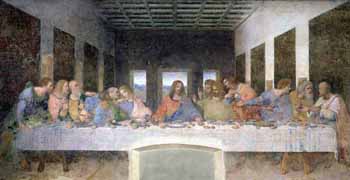| Search Art Prints | ||||||||||||||||||||
| Search Artists | ||||||||||||||||||||

|
||||||||||||||||||||
|
|
|||||||||||||||||||

The Art of Art Restoration
Whether it be a masterpiece or a family heirloom, the act of art restoration is great enough to be regarded as an art itself. The many layers of an oil painting must be unveiled in order to re-establish its original beauty. Imagine the awesome task of restoring the characters in Leonardo Da Vinci's "The Last Supper”, or uncovering the colors Michelangelo had intended for his frescoes that dwell in the Sistine Chapel. This procedure is by no means simple or easy, and the first task is recognizing the signs that a revival is needed. 
Reasons to restore
Having spent years hanging in the family foyer, it is likely that a painting will eventually show signs of spoil or wear and tear. Discoloration, dullness and yellowing are common indications that you might be missing out on some pizzazz. The causes include light exposure, smoke, extremely dry or moist conditions, atmospheric pollution, and any other contaminants that may linger in the air. The experienced restorer will also look for traces of severe progressive problems such as mold, mildew, or insect damage. Since the shellacs and varnishes used hundreds of years ago were not equipped to survive the test of time, old paintings may become dark and lacking in lustre.
Steps to follow
The first step to restoring an oil painting is making sure the canvas on which it exists is in good condition. Fragile canvases are liable to cracks, punctures and tears, and may require relining or remounting. Once the painting is stabilized, the restorer can turn his attention towards the cleaning and re-finishing of the piece.

The amount and nature of the dirt build-up differs from painting to painting, depending on the environment it has lived in. Cleaning the painting begins by testing different chemical solutions which will be used to first, remove the grime, and second, remove old varnish. A proper mixture will successfully eliminate the discoloured varnish, but not the color pigment.
If need be, a third and complicated process comes into play - inpainting. This is done when the restorer must reduce the visibility of damaged areas by making modifications that are aesthetically undetectable. Several methods can be used, but the least complicated is 'diffusion-based inpainting', a procedure by which gas spreads out to fill any given volume. This process allows the colors to diffuse into the missing areas of the image. If the painting is very old and fragile all inpainting is done by hand instead.
Nowadays, an intermediate coat of varnish is applied to the original painting before any inpainting begins. The goal here is to physically separate the new paint from the old to ensure that any future restorations can be done with little or no effect to the original layers. Any paint used thereafter should be non-discoloring synthetic resin paint so that it will not darken faster than the original oil paint. Also, synthetics such as acrylic can be removed with solvents that will not damage the piece.
Finally, the frame must be taken into account to reflect the period in which the painting was created, as it should. Again, a professional restorer will have the ability to replace or mend any broken or missing pieces in the frame, either by re-carving or re-molding the damaged sections using the same material.
To restore, or not to restore
The process of art restoration is a slow one, and understandably so. The restorer must not only be patient, meticulous,  and extremely attentive to detail, but also skilled in the art of art restoration. Each painting is unique in its composition, and the necessary chemistry knowledge is needed to customize the mixtures for each treatment. Professional restoration is pricey so the question is, is it worth it?
and extremely attentive to detail, but also skilled in the art of art restoration. Each painting is unique in its composition, and the necessary chemistry knowledge is needed to customize the mixtures for each treatment. Professional restoration is pricey so the question is, is it worth it?
Mrs. Biddington claims that a painting valued less than $700 may not be worth restoring. But as we say, art is in the eye of the beholder. Whether a beloved painting is appraised at $1000 or $100, would we not wish to view it in all its glory? The experts hired to restore Michelangelo's Sistine Chapel took thirteen years to accomplish the task – twice the amount of time it took the artist himself to paint it. Moral of the story, please do not try this at home!
Donovan Gauvreau
Art Historian, Donovan Gauvreau lectures about art therapy with a focus on creativity development. He believes we can learn from the great masters in art to communicate ideas and feelings through painting. He provides content for www.AaronArtPrints.org to educate and inspire people to take a glimpse into an artist's life to better understand the meaning behind their work.











